Toyota Corolla (2020 year). Owner's manual — part 11

166
4-2. Driving procedures
■
Parking brake operation
●
When the engine switch is not in
ON, the parking brake cannot be
released using the parking brake
switch.
●
When the engine switch is not in
ON, automatic mode (automatic
brake setting and releasing [vehi-
cles with a continuously variable
transmission]) is not available.
■
Parking brake automatic
release function
The parking brake is automatically
released when slowly depress the
accelerator pedal.
The parking brake will be released
automatically under the following
conditions:
●
The driver’s door is closed
●
The driver is wearing the seat belt
●
The shift lever is a forward or
reverse position.
●
The malfunction indicator lamp or
brake system warning light is not
illuminated.
If the automatic release function
does not operate, manually release
the parking brake.
■
If “Parking Brake Temporarily
Unavailable” is displayed on
the multi-information display
If the parking brake is operated
repeatedly over a short period of
time, the system may restrict opera-
tion to prevent overheating. If this
happens, refrain from operating the
parking brake. Normal operation will
return after about 1 minute.
■
If “Parking Brake Unavailable”
is displayed on the multi-infor-
mation display
Operate the parking brake switch. If
the message does not disappear
after operating the switch several
times, the system may be malfunc-
tioning. Have the vehicle inspected
by your Toyota dealer.
■
Parking brake operation sound
When the parking brake operates, a
motor sound (whirring sound) may
be heard. This does not indicate a
malfunction.
■
Parking brake operation
●
Depending on the engine switch
position/mode, the parking brake
indicator and parking brake light
will turn on and stay on as
described below:
ON: Comes on until the parking
brake is released.
Not in ON: Stays on for approxi-
mately 15 seconds.
●
When the engine switch is turned
off with the parking brake set, the
parking brake indicator and park-
ing brake light will stay on for
about 15 seconds. This does not
indicate a malfunction.
■
When the parking brake switch
malfunctions
Automatic mode (automatic brake
setting and releasing) will be turned
on automatically.
■
Parking the vehicle
■
Parking brake engaged warning
buzzer
A buzzer will sound if the vehicle is
driven with the parking brake
engaged. “Parking Brake ON” is dis-
played on the multi-information dis-
play.
-------------------------------------------------------------------------------------------------------------------------------------------------------------

167
4-2. Driving procedures
4
Dr
iv
ing
■
If the brake system warning
light comes on
■
Usage in winter time
*
: If equipped
Turn the brake hold system on
The brake hold standby indicator
(green)
comes on. While the
system is holding the brake, the
brake hold operated indicator (yel-
low)
comes on.
WARNING
■
When parking the vehicle
Do not leave a child in the vehicle
alone. The parking brake may be
released unintentionally and there
is the danger of the vehicle mov-
ing that may lead to an accident
resulting in death or serious injury.
■
Parking brake switch
Do not set any objects near the
parking brake switch.
Objects may interfere with the
switch and may lead the parking
brake to unexpectedly operate.
NOTICE
■
When parking the vehicle
Before you leave the vehicle, set
the parking brake, shift the shift
lever to P (continuously variable
transmission) or N (manual trans-
mission) and make sure that the
vehicle does not move.
■
When the system malfunc-
tions
Stop the vehicle in a safe place
and check the warning messages.
■
When the parking brake can-
not be released due to a mal-
function
Driving the vehicle with the park-
ing brake set will lead to brake
components overheating, which
may affect braking performance
and increase brake wear.
Have the vehicle inspected by
your Toyota dealer immediately if
this occurs.
Brake Hold
*
Continuously variable trans-
mission
The brake hold system keeps the
brake applied when the shift lever
is in D, B (vehicles without paddle
shift switches), M (vehicles with
paddle shift switches) or N with
the system on and the brake
pedal has been depressed to
stop the vehicle. The system
releases the brake when the
accelerator pedal is depressed
with the shift lever in D, B (vehi-
cles without paddle shift
switches) or M (vehicles with
paddle shift switches) to allow
smooth start off.
Manual transmission
The brake hold system keeps the
brake applied when the shift lever
is in a forward driving position or
N with the system on and the
brake pedal has been depressed
to stop the vehicle. The system
releases the brake when the
accelerator pedal is depressed
with the shift lever in a forward
driving position to allow smooth
start off.
Enabling the system
-------------------------------------------------------------------------------------------------------------------------------------------------------------

168
4-2. Driving procedures
■
Brake hold system operating
conditions
The brake hold system cannot be
turned on in the following condi-
tions:
●
The driver’s door is not closed.
●
The driver is not wearing the seat
belt.
If any of the conditions above are
detected when the brake hold sys-
tem is enabled, the system will turn
off and the brake hold standby indi-
cator light will go off. In addition, if
any of the conditions are detected
while the system is holding the
brake, a warning buzzer will sound
and a message will be shown on the
multi-information display. The park-
ing brake will then be set automati-
cally.
■
Brake hold function
●
If the brake pedal is left released
for a period of about 3 minutes
after the system has started hold-
ing the brake, the parking brake
will be set automatically. In this
case, a warning buzzer sounds
and a message is shown on the
multi-information display.
●
To turn the system off while the
system is holding the brake, firmly
depress the brake pedal and
press the button again.
●
The brake hold function may not
hold the vehicle when the vehicle
is on a steep incline. In this situa-
tion, it may be necessary for the
driver to apply the brakes. A warn-
ing buzzer will sound and the
multi-information display will
inform the driver of this situation. If
a warning message is shown on
the multi-information display, read
the message and follow the
instructions.
■
When the parking brake is set
automatically while the system
is holding the brakes
Perform any of the following opera-
tions to release the parking brake.
●
Depress the accelerator pedal.
(The parking brake will not be
released automatically if the seat
belt is not fastened.)
●
Operate the parking brake switch
with the brake pedal depressed.
Make sure that the parking brake
indicator light goes off. (P.164)
■
When an inspection at your
Toyota dealer is necessary
When the brake hold standby indi-
cator (green) does not illuminate
even when the brake hold switch is
pressed with the brake hold system
operating conditions met, the sys-
tem may be malfunctioning. Have
the vehicle inspected at your Toyota
dealer.
■
If “Brake Hold Malfunction
Press Brake to Deactivate Visit
Your Dealer” or “Brake Hold
Malfunction Visit Your Dealer”
is displayed on the multi-infor-
mation display
The system may be malfunctioning.
Have the vehicle inspected by your
Toyota dealer.
■
Warning messages and buzzers
Warning messages and buzzers are
used to indicate a system malfunc-
tion or to inform the driver of the
need for caution. If a warning mes-
sage is shown on the multi-informa-
tion display, read the message and
follow the instructions.
-------------------------------------------------------------------------------------------------------------------------------------------------------------
169
4-2. Driving procedures
4
Dr
iv
ing
■
If the brake hold operated indi-
cator flashes
WARNING
■
When the vehicle is on a
steep incline
When using the brake hold sys-
tem on a steep incline exercise
caution. The brake hold function
may not hold the vehicle in such a
situation.
■
When stopped on a slippery
road
The system cannot stop the vehi-
cle when the gripping ability of the
tires has been exceeded. Do not
use the system when stopped on
a slippery road.
NOTICE
■
When parking the vehicle
The brake hold system is not
designed for use when parking
the vehicle for a long period of
time. Turning the engine switch off
while the system is holding the
brake may release the brake,
which would cause the vehicle to
move. When operating the engine
switch, depress the brake pedal,
shift the shift lever to P (continu-
ously variable transmission) or N
(manual transmission) and set the
parking brake.
-------------------------------------------------------------------------------------------------------------------------------------------------------------
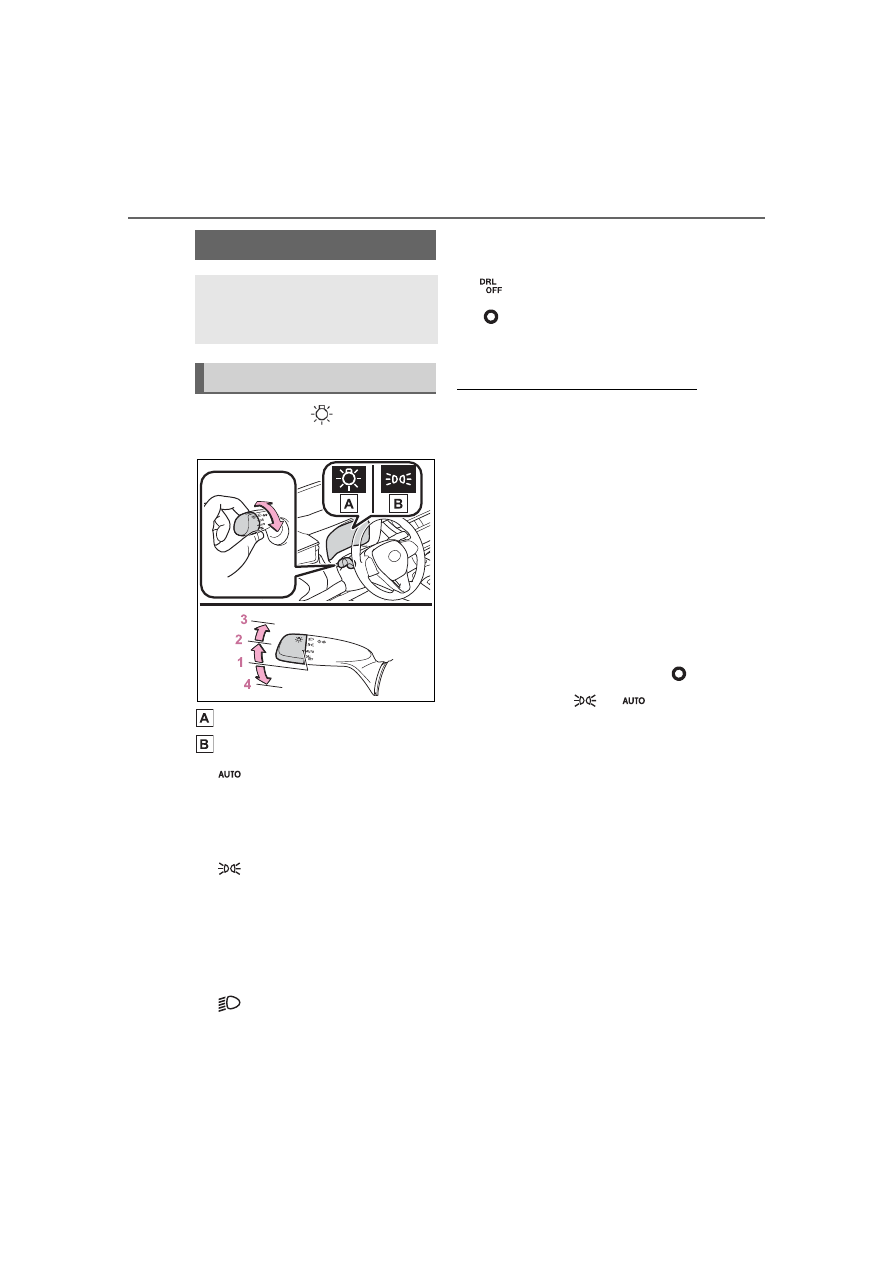
170
4-3. Operating the lights and wipers
4-3.Operating the lights and wipers
Operating the
switch
turns on the lights as follows:
U.S.A.
Canada
1
The headlights, daytime
running lights (P.170) and
all the lights listed below turn
on and off automatically.
2
The side marker, park-
ing, LED accent (if
equipped), tail, license plate,
instrument panel lights, and
daytime running lights
(P.170) turn on.
3
The headlights and all
lights listed above (except
daytime running lights) turn
on.
4
(U.S.A.) Off
(Canada) The daytime
running lights turn on.
(P.170)
■
AUTO mode can be used when
The engine switch is in ON.
■
Daytime running light system
●
The daytime running lights illumi-
nate using the same lights as the
headlights and illuminate darker
than the headlights.
●
To make your vehicle more visible
to other drivers during daytime
driving, the daytime running lights
turn on automatically when all of
the following conditions are met.
(The daytime running lights are
not designed for use at night.)
• The engine is running
• The parking brake is released
• The headlight switch is in the
(Canada only),
or
*
posi-
tion
*
: When the surroundings are bright
The daytime running lights remain
on after they illuminate, even if the
parking brake is set again.
●
For the U.S.A.: Daytime running
lights can be turned off by operat-
ing the switch.
●
Compared to turning on the head-
lights, the daytime running light
system offers greater durability
and consumes less electricity, so
it can help improve fuel economy.
Headlight switch
The headlights can be oper-
ated manually or automati-
cally.
Operating instructions
-------------------------------------------------------------------------------------------------------------------------------------------------------------
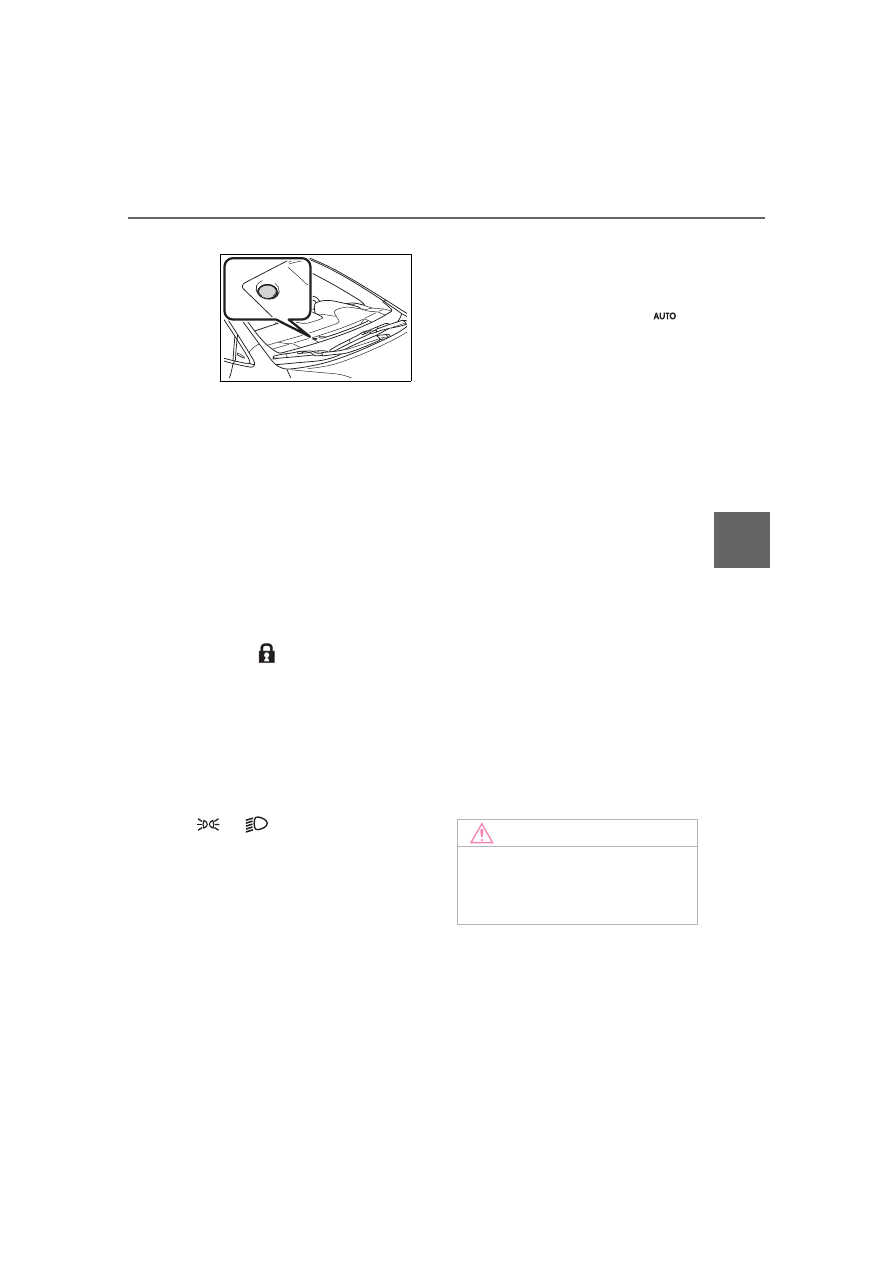
171
4-3. Operating the lights and wipers
4
Dr
iv
ing
■
Headlight control sensor
The sensor may not function prop-
erly if an object is placed on the sen-
sor, or anything that blocks the
sensor is affixed to the windshield.
Doing so interferes with the sensor
detecting the level of ambient light
and may cause the automatic head-
light system to malfunction.
■
Automatic light off system
●
When the headlights are on: The
headlights and tail lights turn off
30 seconds after the driver’s door
is opened and closed if the engine
switch is turned to ACC or OFF.
(Vehicles with a wireless remote
control: The lights turn off immedi-
ately if
on the key is pressed
after all the doors are closed.)
●
When only the tail lights are on:
The tail lights turn off automati-
cally if the engine switch is turned
to ACC or OFF and the driver’s
door is opened.
To turn the lights on again, turn the
engine switch to ON, or turn the light
switch off once and then back to
or
.
■
Light reminder buzzer
A buzzer sounds when the engine
switch is turned to OFF or ACC and
the driver’s door is opened while the
lights are turned on.
■
Automatic headlight leveling
system (if equipped)
The level of the headlights is auto-
matically adjusted according to the
number of passengers and the load-
ing condition of the vehicle to
ensure that the headlights do not
interfere with other road users.
■
Windshield wiper linked head-
light illumination
When driving during daytime with
the headlight switch turned to
, if
the windshield wipers are used, the
headlights will turn on automatically
after several seconds to help
enhance the visibility of your vehi-
cle.
■
Battery-saving function
In order to prevent the battery of the
vehicle from discharging, if the
headlights and/or tail lights are on
when the engine switch is turned off
the battery saving function will oper-
ate and automatically turn off all the
lights after approximately 20 min-
utes. When the engine switch is
turned to ON, the battery-saving
function will be disabled.
When any of the following are per-
formed, the battery-saving function
is canceled once and then reacti-
vated. All the lights will turn off auto-
matically 20 minutes after the
Battery- saving function has been
reactivated:
●
When the headlight switch is oper-
ated
●
When a door is opened or closed
■
Customization
Some functions can be customized.
(P.548)
NOTICE
■
To prevent battery discharge
Do not leave the lights on longer
than necessary when the engine
is not running.
-------------------------------------------------------------------------------------------------------------------------------------------------------------

172
4-3. Operating the lights and wipers
1
With the headlights on, push
the lever away from you to
turn on the high beams.
Pull the lever toward you to the
center position to turn the high
beams off.
2
Pull the lever toward you and
release it to flash the high
beams once.
You can flash the high beams with
the headlights on or off.
AFS (Adaptive Front-lighting
System) secures excellent visi-
bility at intersections and on
curves by automatically adjust-
ing the direction of the light axis
of the headlights according to
vehicle speed and the degree of
the tire’s angle as controlled by
steering input.
AFS operates at speeds of approxi-
mately 6 mph (10 km/h) or higher.
■
Customization
Some functions can be customized.
(P.548)
Turning on the high beam
headlights
AFS (Adaptive Front-light-
ing System) (if equipped)
-------------------------------------------------------------------------------------------------------------------------------------------------------------
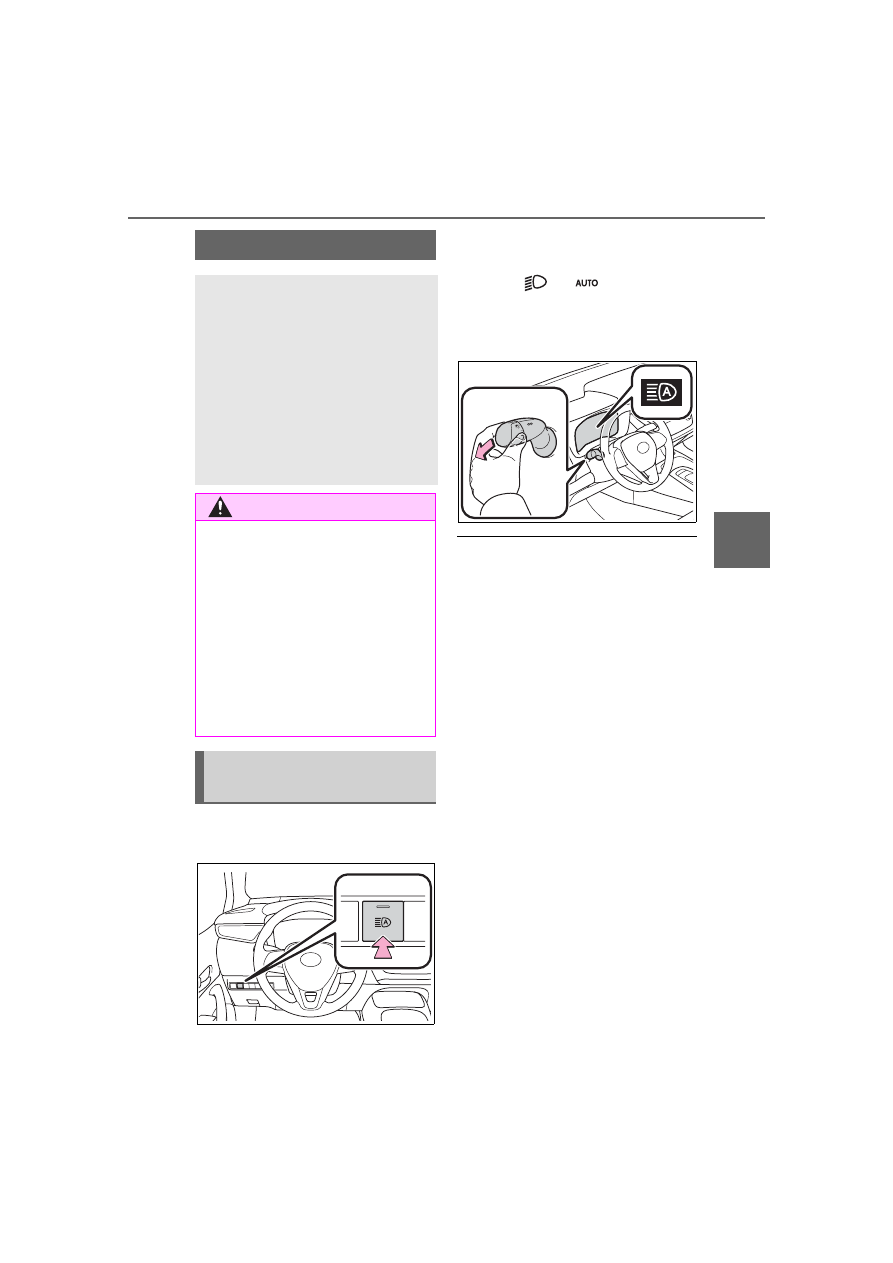
173
4-3. Operating the lights and wipers
4
Dr
iv
ing
1
Press the Automatic High
Beam switch.
2
Push the lever away from
you with the headlight switch
in the
or
position.
The Automatic High Beam indicator
will come on when the system is
operating.
■
Conditions to turn the high
beams on/off automatically
●
When all of the following condi-
tions are met, the high beams will
be turned on automatically (after
approximately 1 second):
• The vehicle speed is approxi-
mately 21 mph (34 km/h) or more.
• The area ahead of the vehicle is
dark.
• There are no vehicles ahead with
headlights or tail lights turned on.
• There are few streetlights on the
road ahead.
●
If any of the following conditions
are met, the high beams will turn
off automatically:
• The vehicle speed is below
approximately 17 mph (27 km/h).
• The area ahead of the vehicle is
not dark.
• Vehicles ahead have their head-
lights or tail lights turned on.
• There are many streetlights on the
road ahead.
■
Camera sensor detection infor-
mation
●
The high beams may not be auto-
matically turned off in the following
situations:
• When a vehicle suddenly appears
Automatic High Beam
The Automatic High Beam
uses a camera sensor
located behind the upper
portion of the windshield to
assess the brightness of the
lights of vehicles ahead,
streetlights, etc., and auto-
matically turns the high
beams on or off as neces-
sary.
WARNING
■
Limitations of the Automatic
High Beam
Do not overly rely on the Auto-
matic High Beam. Always drive
safely, taking care to observe your
surroundings and turning the high
beams on or off manually if nec-
essary.
■
To prevent incorrect opera-
tion of the Automatic High
Beam system
Do not overload the vehicle.
Activating the Automatic
High Beam
-------------------------------------------------------------------------------------------------------------------------------------------------------------
174
4-3. Operating the lights and wipers
from around a curve
• When the vehicle is cut in front of
by another vehicle
• When vehicles ahead cannot be
detected due to repeated curves,
road dividers or roadside trees
• When vehicles ahead appear in a
faraway lane on a wide road
• When the lights of vehicles ahead
are not on
●
The high beams may be turned off
if a vehicle ahead that is using fog
lights without its headlights turned
on is detected.
●
House lights, streetlights, traffic
signals, and illuminated billboards
or signs and other reflective
objects may cause the high
beams to change to the low
beams, or the low beams to
remain on.
●
The following factors may affect
the amount of time taken for the
high beams to turn on or off:
• The brightness of the headlights,
fog lights, and tail lights of vehi-
cles ahead
• The movement and direction of
vehicles ahead
• When a vehicle ahead only has
operational lights on one side
• When a vehicle ahead is a
two-wheeled vehicle
• The condition of the road (gradi-
ent, curve, condition of the road
surface, etc.)
• The number of passengers and
amount of luggage in the vehicle
●
The high beams may turn on or off
unexpectedly.
●
Bicycles or similar vehicles may
not be detected.
●
In the following situations the sys-
tem may not be able to correctly
detect the surrounding brightness
level. This may cause the low
beams to remain on or the high
beams to flash or dazzle pedestri-
ans or vehicles ahead. In such a
case, it is necessary to manually
switch between the high and low
beams.
• When driving in inclement weather
(heavy rain, snow, fog, sand-
storms, etc.)
• When the windshield is obscured
by fog, mist, ice, dirt, etc.
• When the windshield is cracked or
damaged
• When the camera sensor is
deformed or dirty
• When the temperature of the cam-
era sensor is extremely high
• When the surrounding brightness
level is equal to that of headlights,
tail lights or fog lights
• When headlights or tail lights of
vehicles ahead are turned off,
dirty, changing color, or not aimed
properly
• When the vehicle is hit by water,
snow, dust, etc. from a preceding
vehicle
• When driving through an area of
intermittently changing brightness
and darkness
• When frequently and repeatedly
driving ascending/descending
roads, or roads with rough, bumpy
or uneven surfaces (such as
stone-paved roads, gravel roads,
etc.)
• When frequently and repeatedly
taking curves or driving on a wind-
ing road
• When there is a highly reflective
object ahead of the vehicle, such
as a sign or mirror
• When the back of a preceding
vehicle is highly reflective, such as
a container on a truck
• When the vehicle’s headlights are
damaged or dirty, or are not aimed
properly
• When the vehicle is listing or titling
due to a flat tire, a trailer being
towed, etc.
• When the headlights are changed
between the high beams and low
beams repeatedly in an abnormal
manner
• When the driver believes that the
high beams may be flashing or
dazzling pedestrians or other driv-
ers
-------------------------------------------------------------------------------------------------------------------------------------------------------------
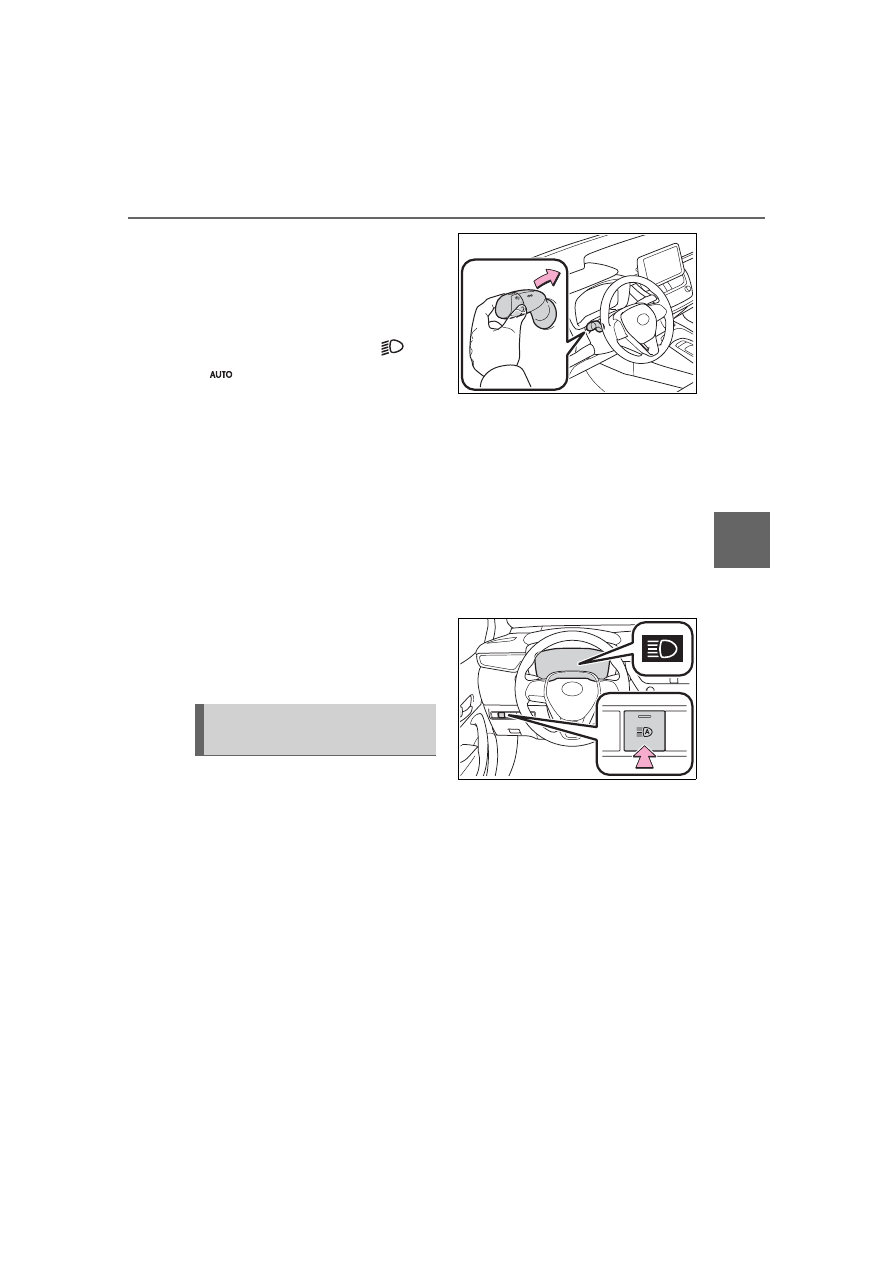
175
4-3. Operating the lights and wipers
4
Dr
iv
ing
■
Temporarily lowering sensor
sensitivity
The sensitivity of the sensor can be
temporarily lowered.
1
Turn the engine switch off while
the following conditions are met.
●
The headlight switch is in
or
.
●
The headlight switch lever is in
high beam position.
●
Automatic High Beam switch is
on.
2
Turn the engine switch to ON.
3
Within 60 seconds after step
2
,
repeat pulling the headlight
switch lever to the original posi-
tion then pushing it to the high
beam position quickly 10 times,
then leave the lever in high beam
position.
4
If the sensitivity is changed, the
Automatic High Beam indicator
is turn on and off 3 times.
Automatic High Beam (headlights)
may turn on even when the vehicle
is stopped.
■
Switching to the low beams
Pull the lever to its original posi-
tion.
The Automatic High Beam indicator
will turn off.
Push the lever away from you to
activate the Automatic High Beam
system again.
■
Switching to the high
beams
Press the Automatic High Beam
switch.
The Automatic High Beam indicator
will turn off and the high beam indi-
cator will turn on.
Press the switch to activate the
Automatic High Beam system
again.
Turning the high beams
on/off manually
-------------------------------------------------------------------------------------------------------------------------------------------------------------

176
4-3. Operating the lights and wipers
Operating the
lever oper-
ates the wipers or washer as fol-
lows.
1
(U.S.A.) or
(Canada)
Intermittent windshield wiper
operation
2
(U.S.A.) or
(Canada)
Low speed windshield wiper
operation
3
(U.S.A.) or
(Canada)
High speed windshield wiper
operation
4
(U.S.A.) or
(Canada)
Temporary operation
5
Washer/wiper dual
operation
Pulling the lever operates the wip-
ers and washer.
Wipers will automatically operate a
couple of times after the washer
squirts.
Interval adjustment type only:
Wiper intervals can be adjusted
when intermittent operation is
selected.
6
Increases the intermittent
windshield wiper frequency
7
Decreases the intermittent
windshield wiper frequency
Windshield wipers and
washer
Operating the lever can use
the windshield wipers or the
washer.
NOTICE
■
When the windshield is dry
Do not use the wipers, as they
may damage the windshield.
Operating the wiper lever
-------------------------------------------------------------------------------------------------------------------------------------------------------------

177
4-3. Operating the lights and wipers
4
Dr
iv
ing
■
The windshield wiper and
washer can be operated when
The engine switch is in ON.
■
If no windshield washer fluid
sprays
Check that the washer nozzles are
not blocked if there is washer fluid in
the windshield washer fluid reser-
voir.
■
When stopping the engine in an
emergency while driving
If the windshield wipers are operat-
ing when the engine is stopped, the
windshield wipers will operate in
high speed operation. After the vehi-
cle is stopped, operation will return
to normal when the engine switch is
turned to ON.
WARNING
■
Caution regarding the use of
washer fluid
When it is cold, do not use the
washer fluid until the windshield
becomes warm. The fluid may
freeze on the windshield and
cause low visibility. This may lead
to an accident, resulting in death
or serious injury.
NOTICE
■
When the washer fluid tank is
empty
Do not operate the switch continu-
ally as the washer fluid pump may
overheat.
■
When a nozzle becomes
blocked
In this case, contact your Toyota
dealer.Do not try to clear it with a
pin or other object. The nozzle will
be damaged.
-------------------------------------------------------------------------------------------------------------------------------------------------------------
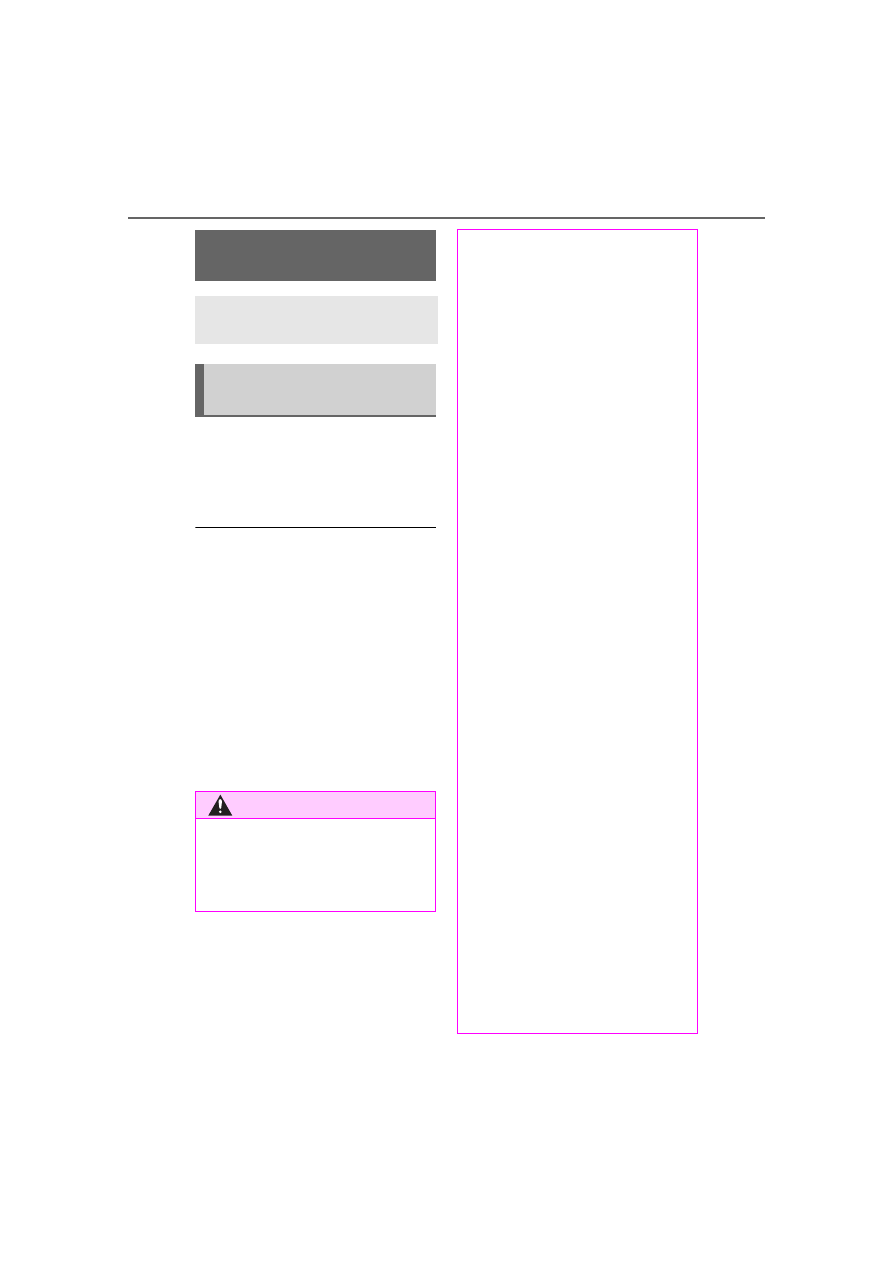
178
4-4. Refueling
4-4.Refueling
Turn the engine switch off and
ensure that all the doors and
windows are closed.
Confirm the type of fuel.
■
Fuel types
■
Fuel tank opening for unleaded
gasoline
To help prevent incorrect fueling,
your vehicle has a fuel tank opening
that only accommodates the spe-
cial nozzle on unleaded fuel pumps.
■
If the malfunction indicator
lamp illuminates
The malfunction indicator lamp may
illuminate erroneously if refueling is
performed repeatedly when the fuel
tank is nearly full.
Opening the fuel tank
cap
Perform the following steps
to open the fuel tank cap:
Before refueling the vehi-
cle
WARNING
■
When refueling the vehicle
Observe the following precautions
while refueling the vehicle. Failure
to do so may result in death or
serious injury.
●
After exiting the vehicle and
before opening the fuel door,
touch an unpainted metal sur-
face to discharge any static
electricity. It is important to dis-
charge static electricity before
refueling because sparks result-
ing from static electricity can
cause fuel vapors to ignite while
refueling.
●
Always hold the grips on the
fuel tank cap and turn it slowly
to remove it.
A whooshing sound may be
heard when the fuel tank cap is
loosened. Wait until the sound
cannot be heard before fully
removing the cap. In hot
weather, pressurized fuel may
spray out the filler neck and
cause injury.
●
Do not allow anyone that has
not discharged static electricity
from their body to come close to
an open fuel tank.
●
Do not inhale vaporized fuel.
Fuel contains substances that
are harmful if inhaled.
●
Do not smoke while refueling
the vehicle.
Doing so may cause the fuel to
ignite and cause a fire.
●
Do not return to the vehicle or
touch any person or object that
is statically charged.
This may cause static electricity
to build up, resulting in a possi-
ble ignition hazard.
■
When refueling
Observe the following precautions
to prevent fuel overflowing from
the fuel tank:
●
Securely insert the fuel nozzle
into the fuel filler neck.
●
Stop filling the tank after the fuel
nozzle automatically clicks off.
-------------------------------------------------------------------------------------------------------------------------------------------------------------
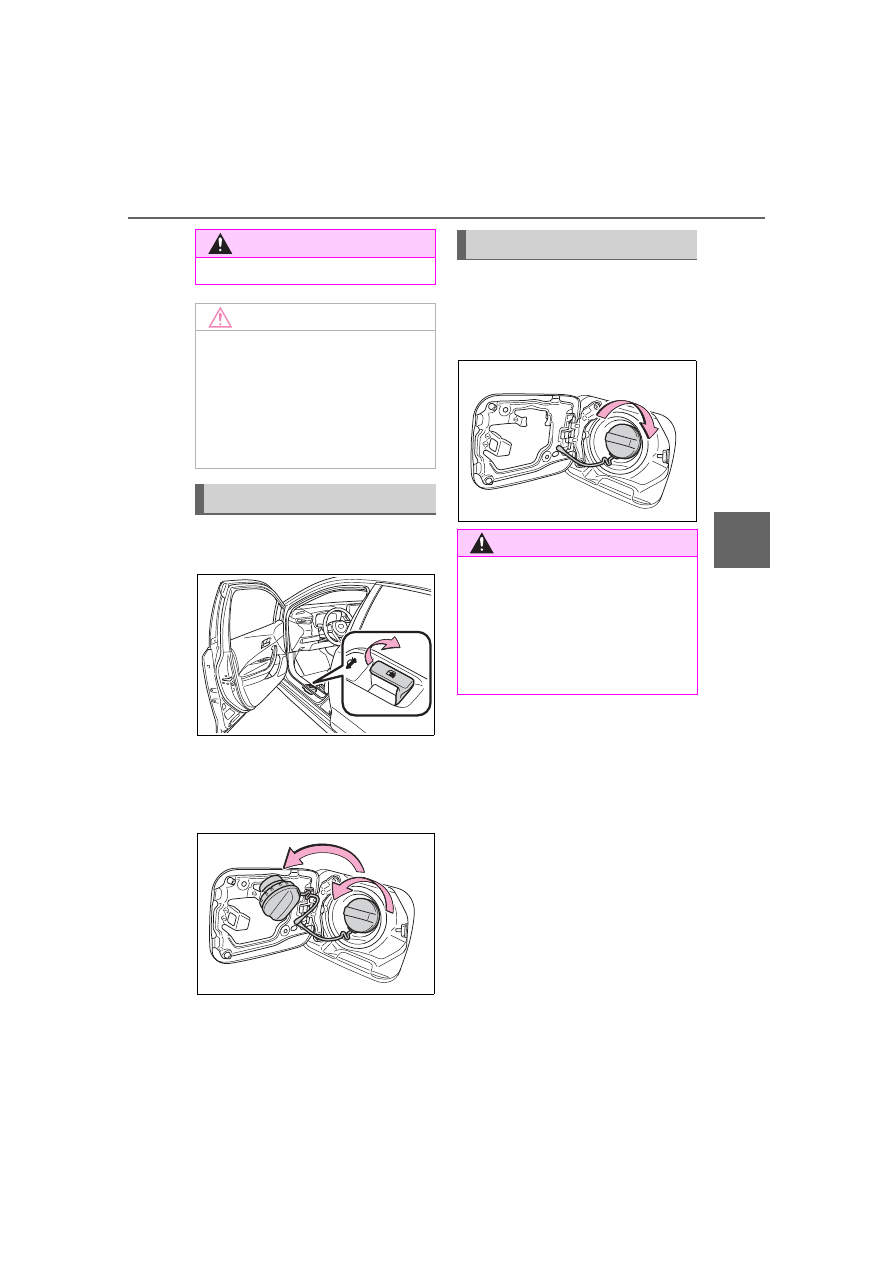
179
4-4. Refueling
4
Dr
iv
ing
1
Pull up the opener to open
the fuel filler door.
2
Turn the fuel tank cap slowly
and remove it, then hang it
on the back of the fuel filler
door.
After refueling, turn the fuel tank
cap until you hear a click. Once
the cap is released, it will turn
slightly in the opposite direction.
WARNING
●
Do not top off the fuel tank.
NOTICE
■
Refueling
Do not spill fuel during refueling.
Doing so may damage the vehi-
cle, such as causing the emission
control system to operate abnor-
mally or damaging fuel system
components or the vehicle’s
painted surface.
Opening the fuel tank cap
Closing the fuel tank cap
WARNING
■
When replacing the fuel tank
cap
Do not use anything but a genu-
ine Toyota fuel tank cap designed
for your vehicle. Doing so may
cause a fire or other incident
which may result in death or seri-
ous injury.
-------------------------------------------------------------------------------------------------------------------------------------------------------------

180
4-5. Using the driving support systems
4-5.Using the driving support systems
■
PCS (Pre-Collision System)
■
LTA (Lane Tracing Assist)
*
*
: If equipped
■
LDA (Lane Departure Alert
with steering control)
*
*
: If equipped
■
Automatic High Beam
■
RSA (Road Sign Assist)
*
*
: If equipped
■
Dynamic radar cruise con-
trol with full-speed range
*
*
: If equipped
■
Dynamic radar cruise con-
trol
*
*
: If equipped
Two types of sensors, located
behind the front grille and wind-
shield, detect information neces-
sary to operate the drive assist
systems.
Radar sensor
Front camera
Toyota Safety Sense
2.0
The Toyota Safety Sense 2.0
consists of the following
drive assist systems and
contributes to a safe and
comfortable driving experi-
ence:
Driving assist system
WARNING
■
Toyota Safety Sense 2.0
The Toyota Safety Sense 2.0 is
designed to operate under the
assumption that the driver will
drive safely, and is designed to
help reduce the impact to the
occupants and the vehicle in the
case of a collision or assist the
driver in normal driving condi-
tions.
As there is a limit to the degree of
recognition accuracy and control
performance that this system can
provide, do not overly rely on this
system. The driver is always
responsible for paying attention to
the vehicle’s surroundings and
driving safely.
Sensors
-------------------------------------------------------------------------------------------------------------------------------------------------------------
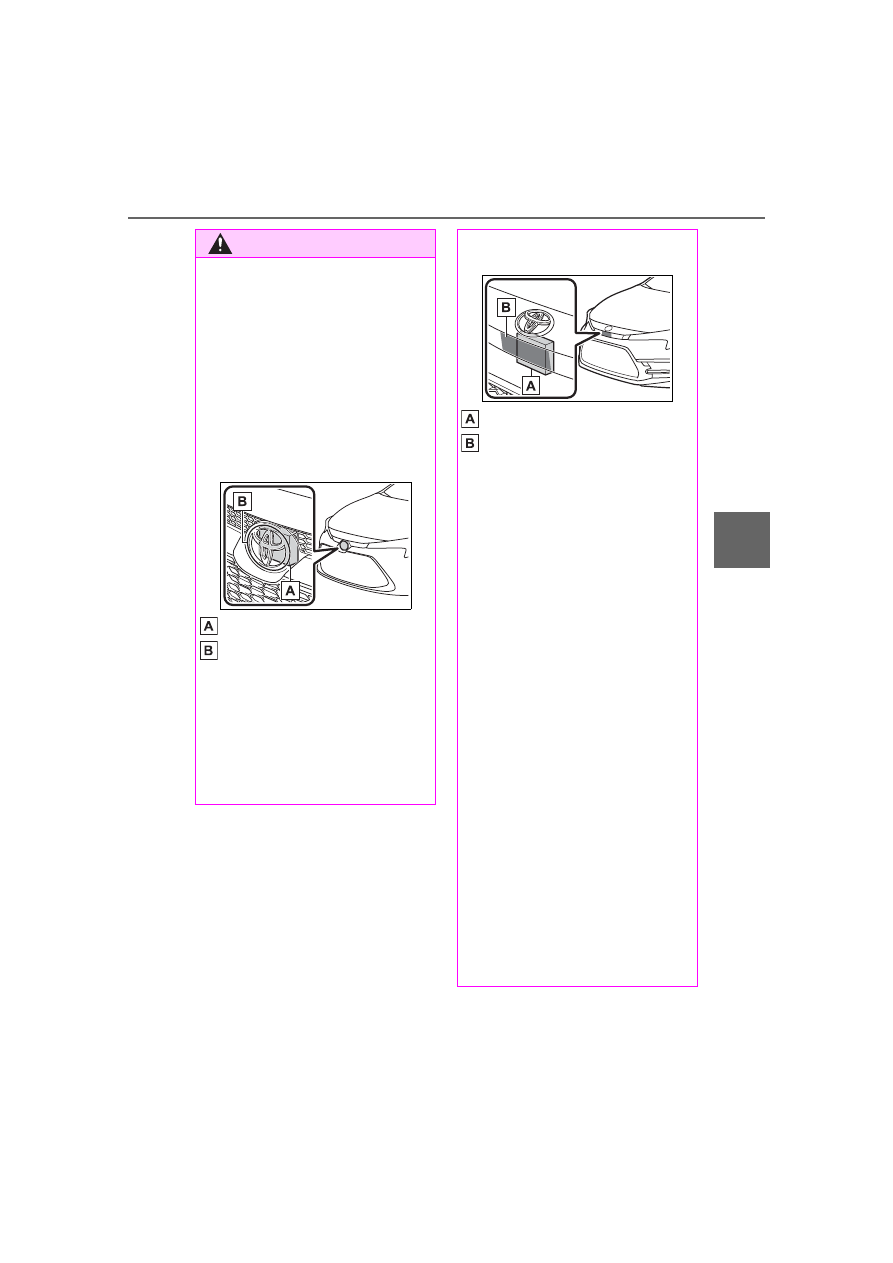
181
4-5. Using the driving support systems
4
Dr
iv
ing
WARNING
■
To avoid malfunction of the
radar sensor
Observe the following precau-
tions.
Otherwise, the radar sensor may
not operate properly, possibly
leading to an accident resulting in
death or serious injury.
●
Keep the radar sensor and the
grille cover clean at all times.
1.8 L 4-cylinder (2ZR-FAE)
engine
Radar sensor
Grille cover
If the front of the radar sensor or
the front or back of the grille cover
is dirty or covered with water
droplets, snow, etc., clean it.
Clean the radar sensor and grille
cover with a soft cloth to avoid
damaging them.
2.0 L 4-cylinder (M20A-FKS)
engine
Radar sensor
Grille cover
If the front of the radar sensor or
the front or back of the grille cover
is dirty or covered with water
droplets, snow, etc., clean it.
Clean the radar sensor and grille
cover with a soft cloth to avoid
damaging them.
●
Do not attach accessories,
stickers (including transparent
stickers) or other items to the
radar sensor, grille cover or sur-
rounding area.
●
Do not subject the radar sensor
or its surrounding area to a
strong impact.
If the radar sensor, front grille,
or front bumper has been sub-
jected to a strong impact, have
the vehicle inspected by your
Toyota dealer.
●
Do not disassemble the radar
sensor.
●
Do not modify or paint the radar
sensor or grille cover.
●
If the radar sensor, front grille,
or front bumper needs to be
removed and installed, or
replaced, contact your Toyota
dealer.
-------------------------------------------------------------------------------------------------------------------------------------------------------------

Нет комментариевНе стесняйтесь поделиться с нами вашим ценным мнением.
Текст